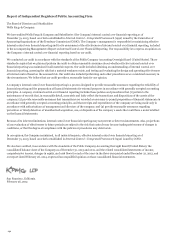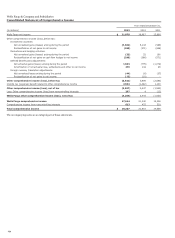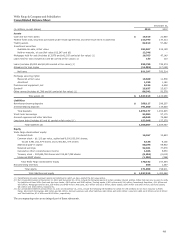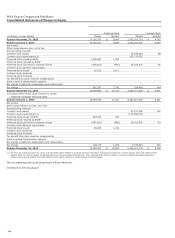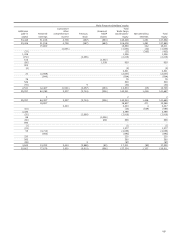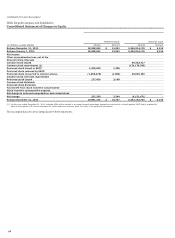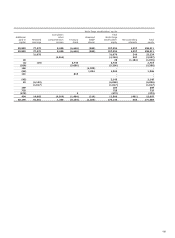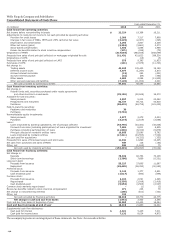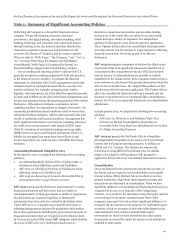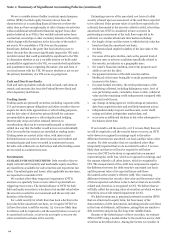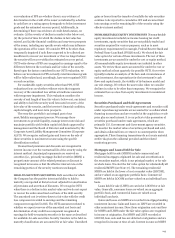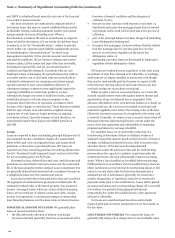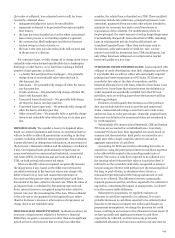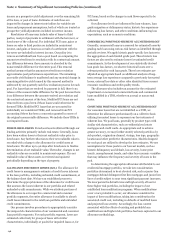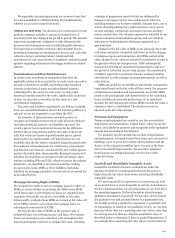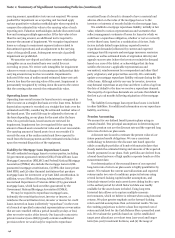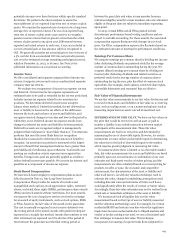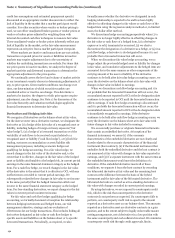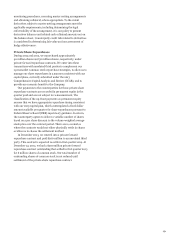Wells Fargo 2013 Annual Report Download - page 143
Download and view the complete annual report
Please find page 143 of the 2013 Wells Fargo annual report below. You can navigate through the pages in the report by either clicking on the pages listed below, or by using the keyword search tool below to find specific information within the annual report.
See the Glossary of Acronyms at the end of this Report for terms used throughout the Financial Statements and related Notes.
Note 1: Summary of Significant Accounting Policies
Wells Fargo & Company is a diversified financial services
company. We provide banking, insurance, trust and
investments, mortgage banking, investment banking, retail
banking, brokerage, and consumer and commercial finance
through banking stores, the internet and other distribution
channels to consumers, businesses and institutions in all
50 states, the District of Columbia, and in foreign countries.
When we refer to “Wells Fargo,” “the Company,” “we,” “our” or
“us,” we mean Wells Fargo & Company and Subsidiaries
(consolidated). Wells Fargo & Company (the Parent) is a
financial holding company and a bank holding company.
Our accounting and reporting policies conform with U.S.
generally accepted accounting principles (GAAP) and practices
in the financial services industry. To prepare the financial
statements in conformity with GAAP, management must make
estimates based on assumptions about future economic and
market conditions (for example, unemployment, market
liquidity, real estate prices, etc.) that affect the reported amounts
of assets and liabilities at the date of the financial statements and
income and expenses during the reporting period and the related
disclosures. Although our estimates contemplate current
conditions and how we expect them to change in the future, it is
reasonably possible that actual conditions could be worse than
anticipated in those estimates, which could materially affect our
results of operations and financial condition. Management has
made significant estimates in several areas, including allowance
for credit losses and purchased credit-impaired (PCI) loans
(Note 6), valuations of residential mortgage servicing rights
(MSRs) (Notes 8 and 9) and financial instruments (Note 17),
liability for mortgage loan repurchase losses (Note 9) and
income taxes (Note 21). Actual results could differ from those
estimates.
Accounting Standards Adopted in 2013
In first quarter 2013, we adopted the following new accounting
guidance:
x
x
x
Accounting Standards Update (ASU or Update) 2011-11,
Disclosures about Offsetting Assets and Liabilities;
ASU 2013-01, Clarifying the Scope of Disclosures about
Offsetting Assets and Liabilities; and
ASU 2013-02, Reporting of Amounts Reclassified Out of
Accumulated Other Comprehensive Income.
ASU 2011-11 expands the disclosure requirements for certain
financial instruments and derivatives that are subject to
enforceable master netting agreements or similar arrangements.
The disclosures are required regardless of whether the
instruments have been offset (or netted) in the balance sheet.
Under ASU 2011-11, companies must describe the nature of
offsetting arrangements and provide quantitative information
about those agreements, including the gross and net amounts of
financial instruments that are recognized on the balance sheet.
In January 2013, the FASB issued ASU 2013-01, which clarifies
the scope of ASU 2011-11 by limiting the disclosures to
derivatives, repurchase agreements, and securities lending
transactions to the extent they are subject to an enforceable
master netting or similar arrangement. We adopted this
guidance in first quarter 2013 with retrospective application.
These Updates did not affect our consolidated financial results
since they amend only the disclosure requirements for offsetting
financial instruments. See Notes 14 and 16 for the new
disclosures.
ASU 2013-02 requires companies to disclose the effect on net
income line items from significant amounts reclassified out of
accumulated other comprehensive income (OCI) and entirely
into net income. If reclassifications are partially or entirely
capitalized on the balance sheet, then companies must provide a
cross-reference to disclosures that provide information about the
effect of the reclassifications. We adopted this guidance in first
quarter 2013 with retrospective application. This Update did not
affect our consolidated financial results as it amends only the
disclosure requirements for accumulated other comprehensive
income. See Note 23 for expanded disclosures on reclassification
adjustments.
In third quarter 2013, we adopted the following new accounting
guidance:
x ASU 2013-10, Derivatives and Hedging (Topic 815):
Inclusion of the Fed Funds Effective Swap Rate (or
Overnight Index Swap Rate) as a Benchmark Interest Rate
for Hedge Accounting Purposes
ASU 2013-10 permits the Fed Funds Effective Swap Rate
(Overnight Index Swap Rate) to be used as a U.S. benchmark
interest rate for hedge accounting purposes, in addition to
LIBOR and U.S. Treasury. The Update also removes the
restriction on using different benchmark rates for similar
hedges. Our adoption of this guidance with prospective
application did not affect our consolidated financial statements.
Consolidation
Our consolidated financial statements include the accounts of
the Parent and our majority-owned subsidiaries and variable
interest entities (VIEs) (defined below) in which we are the
primary beneficiary. Significant intercompany accounts and
transactions are eliminated in consolidation. When we have
significant influence over operating and financing decisions for a
company but do not own a majority of the voting equity
interests, we account for the investment using the equity method
of accounting (we recognize a proportionate share of the
company’s earnings). If we do not have significant influence, we
recognize the investment at cost except for (1) marketable equity
securities, which we recognize at fair value with changes in fair
value included in OCI, and (2) nonmarketable equity
investments for which we have elected the fair value option.
Investments accounted for under the equity or cost method are
included in other assets.
141



